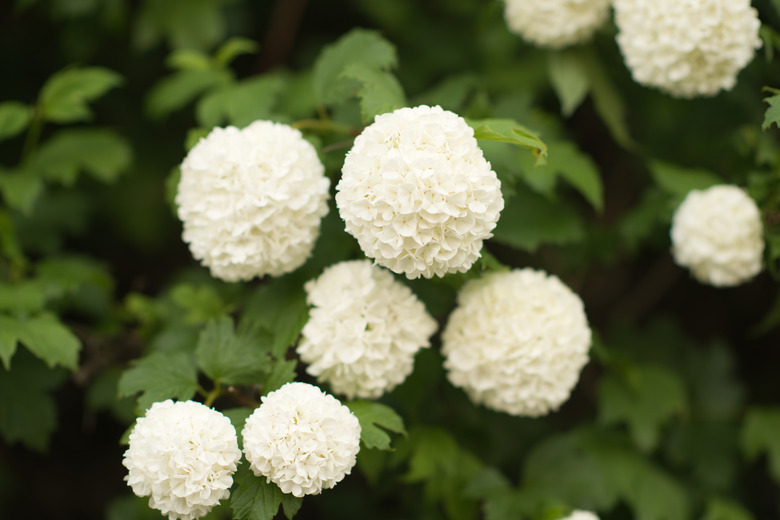How To Care For Snowball Bushes
Snowball bushes (Viburnum spp.) are tall ornamental shrubs that produce vibrant white blooms resembling their wintery namesake. Their colorful spring and summer evolution begins with green blooms before turning bright white and fading to pink as they wither. In the fall, the snowball bush's foliage turns yellow and red, bringing rich autumn color into the garden.
Planting Snowball Bushes
Planting Snowball Bushes
Snowball bushes are perennials in U.S. Department of Agriculture plant hardiness zones 3 through 9, depending on species and cultivar, and they prefer full sun but also do well with partial shade. Best planted in the fall or spring, snowball bushes appreciate well-drained soil. Choose a planting spot that affords the snowball plenty of room to grow. Snowballs like to spread their roots and some can grow as high as 15 feet. A spot receiving six to eight hours of bright sun each day is ideal.
Dig a hole as deep as the rootball and twice as wide to accommodate the bush's root ball so the roots have enough room to spread out. Add compost to enrich the soil over the planting site, and thoroughly water after planting to help ease the roots into their new home. Top the soil with mulch to conserve water and protect the roots from weeds and the elements. Young snowballs appreciate frequent watering, about three to five times a week during hot summer months. Established snowball bushes can take less frequent watering. Water snowballs at ground level to keep the foliage dry, which helps keep fungal diseases at bay.
Caring for Snowball Bushes
Caring for Snowball Bushes
Snowball bushes don't require heavy feeding, and too much fertilizer can promote rot. Use a balanced 10-10-10 NPK fertilizer in early spring if desired. Pinch spent blooms to help promote new growth.
Regular pruning is necessary to keep snowball bushes tidy. Trim dead, diseased or damaged branches in late winter or early spring. Apply mulch to the soil around the snowball bush each season to keep roots warm and deter weeds, pulling the mulch away from the base of the plant.
Insects and Disease
Insects and Disease
Snowball bushes attract a variety of insects including aphids, beetles and caterpillars. Spray with an appropriate pesticide if pest damage crosses the threshold of what's acceptable to you, following the directions on the label.
Snowballs are prone to fungal spots and mildew on their leaves, especially during the warm summer months. Monitor leaves for the sign of mold or fungus and apply an appropriate fungicide. It's important to note that fungicides work better as a preventive (before a fungal disease takes hold) instead of a curative (after the disease is present). So if your snowball bush has a problem with fungal diseases, apply a fungicide when the new growth emerges the following spring, and reapply according to the label directions to prevent disease. Water plants at the roots as sitting moisture on leaves promote fungus and mildew.
Snowball Bush Propagation
Snowball Bush Propagation
Take snowball bush cuttings in late spring to mid-summer. Look for new growth about 6 inches long with leaves on the branch. Prune the branch just under a leaf node, using sanitized pruning shears to prevent disease. Strip off lower leaves and any blossoms to avoid rot after planting.
Prepare a rooting container with vermiculite and water thoroughly. Allow the pot to drain before planting the cutting. Use a finger or dowel to make a hole 2 to 3 inches deep and insert the snowball bush cutting. Press the vermiculite around the cutting so it's snug in the container and give it another thorough watering. Make sure the pot is placed in a warm, shady area out of direct sunlight.
Water the cutting thoroughly as needed, keeping the vermiculite moist but not soggy. When roots are established, usually about six to eight weeks later, transplant to a pot filled with potting soil. If the plant is growing well, plant in the garden about four weeks after potting.
